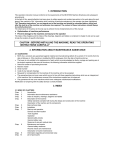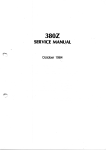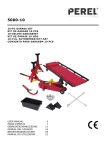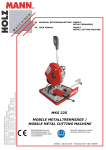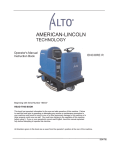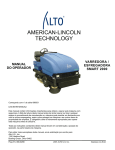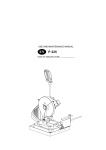Download MEC TE250
Transcript
1. INTRODUCTION This operation instruction manual conforms to the requirements of the 98/37/EEC Machine Directives and subsequent amendments. In the light of this, special attention has been given to safety aspects and accident prevention in the work-place for each stage in the machine's "life". Information which could be of particular assistance to the operator has been highlighted. The "Operating instructions" are an integral part of the machine and should be consulted before, during and after the start up of the machine and whenever else required. The content of these instructions should always be carefully observed. The observance of the above is the only way to achieve the two fundamental aims of this manual: • Optimisation of machine performance • Prevent damage to the machine and injury to the operator The index of the chapters and the index of the drawings, diagrams and tables are contained in chapter 3 and can be used to help the location of specific information. CAUTION: BEFORE INSTALLING THE MACHINE, READ THE OPERATING INSTRUCTIONS CAREFULLY 2. INFORMATION ABOUT MAINTENANCE ASSISTANCE 2.1 GUARANTEE • MIVA. products are guaranteed against material and manufacturing defects for a period of 12 months from the date of delivery or, if the machine is installed by MIVA employees, from the date of machine start up. • The buyer is only entitled to the replacement of parts which are acknowledged as faulty: carriage and packing are at the buyer's expense.In the event of the above, the following information should be supplied: 1. Date and number of purchasing document 2. Machine model 3. Serial number 4. Code of any relevant drawings • Requests for compensation for the inactivity of the machine will not be accepted. • The guarantee does not cover uses which are not in line with these operating instructions which are an integral part of the machine. Nor is maintenance covered if the instructions supplied are not observed. • The guarantee will not cover machines which have undergone unauthorized modifications. • Modification or tampering with the safety devices is strictly forbidden. 3. INDEX 3.1 INDEX OF CHAPTERS Chap. 1 Introduction Chap. 2 Information about maintenance assistance Chap. 3 Index of chapters, drawings, diagrams and tables Chap. 4 Description of the machine Safety standards complied with during the design and construction of the machine Description of the machine and its components Chap. 5 Main technical data Chap. 6 Handling and transportation Chap. 7 Installation Chap. 8 Start up and operation Devices and their location Tools supplied Operation Special safety checks General safety rules Measures to prevent residual risks Chap. 9 Maintenance and repairs General safety measures Routine checks and maintenance Description of routine maintenance Chap. 10 Information regarding environmental noise Chap. 11 List of spare parts Chap 12 Laying of - Demolition 3.2 INDEX OF DRAWINGS, DIAGRAMS AND TABLES ENCL. TYPE Table Drawings Drawings Diagram Drawings Drawings Drawing DESCRIPTION Choice of circular blade Handling and transportation- Installation plan Electrical details Electrical installation Motor-blade block Base block and vice Machine assembly ENCL No. CHAP. 1 2 2 3 4 4 5 8.3 6/7/8 7 7/8.3/9 8.3/9.3 8.3 4. DESCRIPTION OF THE MACHINE 4.1 SAFETY STANDARDS COMPLIED WITH DURING THE DESIGN AND CONSTRUCTION OF THE MACHINE The machine produced by us is in compliance with: • 98/37/EEC Machinery Directive (ex 89/392/EEC, as amended by the 91/368/EEC, 93/44/EEC and 93/68/EEC Directives ). The following Standards apply: - EN 292-1 1991 Safety of machinery - Basic concepts and general principles for design. Basic terminology and methods. - EN 292-2 1991 Safety of machinery. Basic concepts and general principles for design. Specifications and technical principles. - EN 418 1994 Safety of machinery. Emergency stop devices, functional aspects - design principles. - EN 983 1996 Safety requirements related to systems and components for hydraulis and pneumatic transmissions. - EN 1037 1995 Safety of machinery. Isolation and energy dissipation. Prevention of unexpected start-up. - EN 1088 1995 Safety of machinery - Interlocking devices with and without guard - locking. General principles and provisions for design. - EN 60204-1 1998 Safety of machinery. Electrical equipment of machines. Part 1 : General requirements Sa - EN 60204-2 1990 Electrical equipment of industrial machines. Part 2: Item designation and examples of Drwg.ings, diagrams, tables and instructions. - EN 31202 Noise measurement at the operator’s position • 89/336/EEC Directive on electromagnetic compatibility, as amended by the 92/31/EEC, 96/68/EEC, 93/97/EEC and 93/68/EEC The following Standards apply: − − EN 50081-1 EN 50082-1 General Standard for emission levels General Standard for immunity • 73/23/EEC Low Voltage Directive, as amended by the 93/68/EEC Directive 4.2 DESCRIPTION OF THE MACHINE AND ITS COMPONENTS The 250 cutting-off machine with circular blade for ferrous metals produced by MIVA is made from a solid casting, carefully processed and provided with holes for fastening to a bench or pedestal. The upper surface, designed to allow the complete draining away of the cutting fluid, has been processed using precision machinery to allow the attachment of a sturdy vice with burr-proof jaws. The bar-stop device allows the length required to be preset and a constant level of performance for repeated cuts. The blade-holding head is firmly attached to a reduction unit in oil bath built onto the motor and to the base by means of a joint which provides 45° rotation both to the left and right and the cutting movement with manual feed. The coolant pump is also securely attached to the motor block. The main switch is located above the motor block. Another switch is used to select motor rotation speed and therefore cutting speed. The control lever, fitted with an ergonomic hand-grip and blade activation button with safety release action, reduces fatigue during operation to a minimum. The blade is protected by a guard which in its turn protects the operator from ejected shavings and coolant. The machine is supplied with a set of service spanners. 4.3 INTENDED AND UNSUITABLE USES OF THE MACHINE The 250 cutting-off machine with circular blade has been designed and built to cut bars, structural steel and ferrous metal pipes in accordance with the instructions contained in this manual. Therefore, the cutting of other materials is not permitted: if the above recommendations are not observed, the machine could be damaged and the health and safety of the operator put at risk. Cutting is not permitted, if the bar has not been first locked in the vice. 5. MAIN TECHNICAL DATA Under no circumstances should the following data be altered, this is in order to protect the correct functioning of the machine and to avoid creating safety risks for the operator. MOTOR three-phase or single-phase Motor Power three-phase KW 0,95/1,32 - single-phase KW 0,9 Motor revolutions (two speeds) 1400-2800 rpm CIRCULAR BLADE (SAW) Number of teeth and feed holes according to table Maximum diameter and thickness Diameter: 250 mm Thickness: 2 BLADE REVOLUTIONS per minute 52-104 rpm CUTTING ANGLE 45° right - 45° left PIECE LOCKING VICE: MAX OPENING 100 mm COOLANT TANK CAPACITY litres 3 MACHINE WEIGHT 85 kg - 833,5 N 6. HANDLING AND TRANSPORTATION For safe handling and transportation use a lift truck for movement indoors or a bridge crane; in this case, also using cables fastened to the sling positions indicated on the drawing 1 Encl. 2. Keep the machine in its normal position and avoid turning it upside down. If the machine is fastened to the pedestal, stability will be greatly reduced and therefore all the necessary measures should be taken to stop the machine from tipping over. All handling and transportation operations should be carried out by trained staff. 7. MACHINE INSTALLATION A. MACHINE CHECK AND CONTROL LEVER ASSEMBLY The machine should be checked to make sure that it has not been damaged during transportation and handling. Control lever assembly (drawing 4. Encl. 2) : Fit the supplied head lever 22, into position 21 and fasten it by means of the nut 86. To fit the handle, connect the electric cable terminals 220 to the microswitch 218 and place it in the left second half of the handle as shown in draw. 4 Encl.2. Then insert the button 222 and the lever 22. Complete the assembly using the screws 221 and then 219. Make sure that the cable is inserted into the lever slot 22, after having checked that there are no burrs or sharp edges in the slot. B. FASTENING OF THE MACHINE The machine will be able to operate in keeping with the technical parameters supplied by MI.VA. if it is positioned correctly and fastened securely to the bench or the factory floor so that vibrations are minimal during operation . Consult drawing 2 250 Installation plan Encl. 2. C. ASSEMBLY OF CIRCULAR BLADE For the assembly of the circular blade, remove the screw No. 52 (Draw. 6 Encl. 4), keeping the motor-blade block raised and rotate the mobile guard 76 backwards. Unscrew the screw 25 clockwise, withdraw the flange 27, insert the circular blade, making sure that the toothing faces the same direction as the arrow on the mobile guard. Then refit flange 27 and screw 25. D. ELECTRICAL CONNECTION TO THE MAINS Install a differential thermomagnetic switch with characteristics suited to the mains. Make sure that the power supply voltage corresponds to the voltage on the motor plate. Connect the cable to the power supply line observing the colour codes of the individual wires, pay particular attention to the earth wire. Connect the machine, make sure that the rotation of the circular blade is in the direction shown by the arrow on the guard. E. CUTTING COOLANT For the cooling of the circular blade, fill the tank with emulsible oil obtained from a mixture of water and AGIP ULEX 260 EP oil with a percentage of 5-7% 8. MACHINE START UP AND OPERATION 8.1 DEVICES AND THEIR LOCATION (The location of the devices described is shown on the 250 installation plan Encl. 2) Code 212 LOCKABLE MAIN SWITCH Code 218 START-STOP MICROSWITCH: situated inside the handle located at the end of the control lever and has safety release action. Code 208 EMERGENCY STOP Code 37 CUTTING ANGLE DEVICE: to check that cutting inclination is as required Code 59 LOCKING VICE Code 45 BAR-STOP Code 22 CONTROL LEVER WITH HANDLE 8.2 TOOLS SUPPLIED 1 Allen wrench size 3 1 Allen wrench size 4 1 Allen wrench size 5 1 Allen wrench size 6 1 Allen wrench size 14 8.3 OPERATION CHECKS TO CARRY OUT BEFORE EACH CUT A. Make sure that the circular blade is fastened securely by means of screw 25 (DRAW.6 ENCL.4) B. Check that the hand indicates the required cutting angle (vice scale) C. Make sure that the head and vice are locked by means of the lever 50 (DRAW.7-8 ENCL.4) D. With the motor off, lower the head and check that at the end of the stroke, the circular blade does not touch the counter-vice 43. If the circular blade does touch, adjust the screw 40 located at the centre of the head support 17 (DRAW.5 ENCL.4) E. Make sure that the piece to be cut is adequately secured in the vice. F. Make sure that the coolant is circulating in the machine. CUTTING OPERATION A. Before each cutting operation, if the cutting inclination is not as required, correct or change the inclination by placing the bench lever 50 in position 2 (DRAW.8 ENCL.4) and after correction, forcefully turn it to position 1. B. Clamp the piece to be cut by means of the handwheel 55 (DRAW.7 ENCL.4), turn the main switch 212 and the speed switch 203 to the position required (we recommend No.1), use the second speed 104 RPM only in case of need and no longer than 5 minutes in 1 hour. Take hold of the handle 78 located at the end of the head lever and press button 218. The blade will now start turning. C. Position the blade carefully on the piece to be cut. Then increase the pressure in order to accelerate the cutting operation without using excessive force. To make a series of cuts, position the bar-stop 45 at the size required. Fix it into position by using the knob 46 (DRAW.9 ENCL.5). D. To replace the circular blade carry out the same operations used to assemble the circular blade. (chapter 7c). E. For the choice of most suitable blade consult the table ENCL. 1. We strongly discourage the use of blades with ruined or insufficiently sharp cutting edges 8.4 SPECIAL SAFETY CHECKS A. Before using the machine, check carefully that the safety devices are in good working order, that the mobile parts are not blocked, that no parts are damaged and that all the components are installed correctly and are functioning properly. B. Make sure, before operating the machine, that the screws of the guards and other protective devices are adequately secured, especially the screws on the circular blade guard and the rotation levers of the circular blade mobile guard. C. Check that the safety microswitches and the emergency button are functioning correctly. Test them during a loadless machine cycle. D. Make sure that the mobile guard does not leave uncovered an angle of more than 5° in order to prevent fingers from entering. E. Pay attention to environmental conditions. Do not expose the machine to rain; to not use it in damp environments, position the machine on a clean dry floor that has no oil or grease stains. F. Before using the machine, the operator should make sure that all tools and service spanners used for maintenance or adjustment have been removed. 8.5 GENERAL SAFETY RULES A. Wear appropriate clothing. The operator's clothing should not be loose or dangling nor should it have parts which could easily get caught. Sleeves should contain elastic. Belts, rings or chains should not be worn. Long hair should be kept in a net. B. Avoid unstable operating positions. Find a safe and evenly balanced position to operate the machine. C. Keep the work area tidy, untidiness increases the risk of accidents. D. Do not use the power supply cable to disconnect the plug from the socket. Protect the cable from high temperatures, oil or sharp edges. For outdoor use, only use extension cables which are in line with current regulations. 8.6 MEASURES TO PREVENT RESIDUAL RISKS A. The removal of guards and tampering with the safety devices is strictly forbidden. B. Gloves should always be worn. C. Standard work clothing should be used and kept closed and should not have flapping parts. D. The machine should not be cleaned with liquids under pressure. E. In the event of fire, extinguishers should not be used unless they are the powder type. The electric power supply to the machine should always be disconnected in these circumstances. F. Do not insert foreign bodies into the motor cover and to not supply the machine with voltage by tampering with the safety microswitches or main switch. G. Take the necessary precautions to avoid the machine being started by other people during loading, adjustment, piece changing or cleaning. Safety, Guidance, Notice Labels on the Machine 9. MAINTENANCE AND REPAIRS 9.1 GENERAL SAFETY MEASURES A. Lockable main switch. Open the padlock in the event of machine failure or replacement of the circular blade. The padlock key should be entrusted to a responsible person. B. Before carrying out any work on electrical equipment, remove the power supply plug from the control panel (disconnect voltage). C. Only use cables to supply power, which have a cross-section suited to the power of the machine. D. Opening key. The keys of the machine should be kept by authorized personnel. Do not leave the keys for doors which provide access to the hydraulic or electrical parts or keys to lockable switches in easy of reach of unauthorized personnel. E. Repairs should only be carried out by authorized personnel. Only spare parts made by the original manufacturer should be used, otherwise these could cause damage or injury. 9.2 ROUTINE CHECKS AND MAINTENANCE FREQUENCY (working hours) 1000 hours 1000 50 if necessary OPERATION Replace the oil in the gear box with AGIP ACER 320 oil (0.2 litres) or equivalent. Lubrication of mobile parts in the piece locking vice (GREASE AGIP MU 2) Cleaning of the coolant tank and filter check Check functioning of bench lever 9.3 DESCRIPTION OF ROUTINE MAINTENANCE A. Replacement of gear box oil Remove caps 34 and 90 (draw.5-6 Encl.4), let all the used oil flow out into a container which should have a label indicating the contents for the purposes of disposal. Replace cap 34. Feed 0.2 litres of oil (as specified above) into the oil feed hole located on the upper part of the gear box and then replace cap 90. B. Lubrication of mobile parts of piece locking vice Remove jaw 60 (draw.7 Encl.4), withdraw vice 59 completely by turning hand wheel 55. Clean and grease the parts worked by the counter-vice 43 and vice 59. Put a drop of oil in the oil feed hole 61 located behind the handwheel. C. Cleaning of the coolant tank: Filter check. Empty the coolant from the tank by means of the tap located on the rear part of the machine bench (after moving the liquid feed pipe away from this). Collect the coolant in a container for future disposal. Remove screws 64 and the drilled plate 62 (draw.8 Encl.4). Clean out the shavings and the metallic powder, taking care not to scatter this over the machine especially around the motor and the box containing the electrical equipment. Refit the plate 62 and fasten it with screws 64, turn the tap off and reconnect the pipe. Check filter 88 and if necessary replace it. Fill the tank with the amount and liquid stated previously. D Checking of bench lever functioning Check regularly that the rotation release - locking lever is working properly. In the event of the lever not locking correctly, loosen grub screw 51 (draw.7 Encl.4), tighten nut 49 and fasten grub screw 51 again. Make sure that with the bench lever in position 2, arm 17 which supports the blade-motor block can rotate freely. 10.INFORMATION REGARDING ENVIRONMENTAL NOISE An environmental noise test carried out on the 250 cutting-off machine with circular blade, identical to the machine to which these operation instructions refer, has given the following results: ACOUSTIC RADIATION PRESSURE 1. LAeq = 83.2 dB (A) 2. Lpeak = 90.6 dB (the maximum acceptable value is 140 dB). 3. The level of background noise has no influence = 48.5-54.2 dB (A). 11. LIST OF SPARE PARTS POS. 1 2 3 4 5 6 7 8 9 10 11 12 13 14 15 16 17 18 19 20 21 22 23 24 25 26 27 28 29 30 31 32 33 34 35 36 37 38 39 40 41 42 43 44 45 46 47 48 49 50 51 52 53 54 55 56 57 58 59 60 DESCRIPTION Worm screw fastening nut Worm screw Key 5x5x30 DIN 6885 Splash guard 25-47-7 Bearing 6205 ZZ Rotor Stator Head gear Bearing 6204 ZZ Bearing 629 Snap ring D.9 DIN 471 Pump carrier Motor casing Screw TE 8x20 DIN 933 Nut M8 DIN 934 Head carrying arm Motor flange Key 7x8x30 DIN 6885 Helical gear Head Head lever Screw TCCE 8x20 DIN 912 Washer Disk fastening screw Disk shaft Disk flange Splash guard 30-40-7 Disk guard Water pipe Washer A.C. Pump Oil level plug Pointed dowel 6x10 DIN 914 Pin head Graduated scale Screw TCCE 6x12 DIN 912 Disk Screw TE 8x30 DIN 933 Screw TE10x40 DIN 933 Bench Countervice Bar stopped rod Bar stopped Bar stopped knob Dowel 6x10 DIN 914 Countervice pin Bench lever nut Bench lever Dowel 6x10 DIN 914 Screw TCCE 6x16 DIN 912 Screw TE 10x25 DIN 933 Elastic pin 16x16 DIN 1481 Vice handwheel Bush Elastic pin 8x36 DIN 1481 Vice screw Vice Vice ljaw CODE 021/05 040/05 151/36 043/05 003/05 005/05 019/05 008/05 039-A/05 018/05 016/05 017/05 044/05 009/05 POS. 61 62 63 64 65 66 67 68 69 70 71 72 73 74 75 76 77 78 79 80 81 82 83 84 85 86 87 88 89 90 91 DESCRIPTION Oiler Crucible Bench tap Screw TCCE 6x55 DIN 912 Nut M 16 Din 936 Screw TCCE 6x20 DIN 912 Washer D.6 DIN 125/A Screw TCCE 4x12 DIN 912 Fan guard Fan Nut M 8 DIN 934 Screw TCCE 6x20 DIN 912 Disk movable guard fixed rod Disk movable guard Snap ring D.45 DIN 471 Head lever handle Dowel 8x35 DIN 914 Jet-breaker Pedestal Screw TE 10x25 DIN 933 Washer D.10 DIN 125/A Mobile antifraze bracket Fixed antifraze bracket Nut M 14 DIN 934 Screw TCCE 6x20 DIN 912 Filter FB 1 Movable guard rod Oil filling cap Flange rear motor CODE 037/05 042/05 011/05 010/05 046/05 020/05 001/71 030/05 025/05 045/05 012/05 041/05 023/05 024/05 001/05 015/18 031/05 004/05 077/25 026/05 032/95 002/05 029/03 013/05 016/18 029/05 200 201 202 203 204 205 206 207 208 209 210 211 212 213 214 215 216 217 218 219 220 221 222 Box Cover box Plate Omega raceway Changeover switch RH screw M4x14 DIN 7981 HSHC screw M4x6 DIN 912 Fuse blok PCH 3x38 Contact Emergency button TBEI screw M4x6 ISO 7380 Remote controlled switch 032/90 Main switch 002/90 RH screw M4x14 DIN 7981 Fuse blok PCH 2x38 Fuse blok PCH 1x38 Transformer 20 VA Micro switch of handle HSFHC screw M4x8 DIN 7991 Electrical cable 2x1 RH screw M2,9x13 DIN 7981 Button 066/90 067/90 069/90 011/90 092/90 085/90 094/90 093/90 092/90 028/90 12. LAYING OFF AND DISMANTLING 12.1 LAYING OFF If the machine is to be laid off or left idle for a long period, the following operations must be carried out: 1. Disconnect the machine from the electricity mains. 2. Empty oil from the gear box and cooling liquid from its tank 3. Clean carefully the machine by getting rid of all traces of grease, especially on the worked parts that must be protected with anti-oxidants. 4. Cover the machine with a sheet, preferably not plastic as it can cause rust due to the humidity condensation. 5. Store the machine in a closed, dust-free place. 12.2 DISMANTLING If the machine must be definitively dismantled, its components must be sub-divided for the purpose of a possible recycle of the materials and for the environment safety. The following table is given for your guidance: Steel Bolts Springs Flanges Pins, pivots Light alloy Cylinders Cast iron Structural parts Bronze Copper Motors winding Plastic Various Seals Flexible pipes Gaskets Gearboxes Bushings Friction items Used oil and materials must be disposed of according to 75/439/EEC and 87/101/EEC Directives and to country specific regulations

















